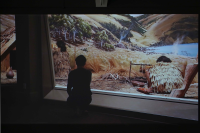
Perilous: Untold stories from the collection is the collection show at Te Puna o Waiwhetū that will be on exhibition until 2024. The exhibition is themed to counter the male, Western, heterosexual art history narratives which have been (and still are, although this looks likely to change) prioritised in our galleries. Perilous is formed into eight different curated sections and rooms. My favourites are: Walking Backward into the Future, rethinking history and heritage, foregrounding the stories of tangata whenua; Mediated Reality, photographs which I found as captivating as the video works which punctuate your journey through the many rooms; and Every Body, containing works like Angela Tiataia’s Heels (2014) and Ruth Buchanan’s Brain Building Body (2015). Before I celebrate this exhibition, however, I want to wonder…
According to books.google.com, perilous was a popular word in the 1800s. Since about 1850 its use has steadily declined, at its lowest in the 1980s. The 1980s was the beginning of the HIV/AIDS epidemic. It was also a very active time for civil rights progress following the protests and mahi of the previous decades. In Aotearoa: ’81 were the Springbok Tour protests; ’85 Keri Hulme won the Booker Prize for The bone people, in the same year the Waitangi Tribunal was granted power to investigate claims dating back to 1840; ’86 the Ngāi Tahu claim was filed, and in the same year the 1986 Homosexual Law Reform bill was passed, decriminalising consensual homosexual conduct between males; ’87 Māori Language Act was passed, in the same year that the first Indigenous written and directed film was released: Barry Barclay’s Ngāti.
Yet, during this time, perilous was a word rarely published. It has since come back into fashion, rising in popularity in the last twenty years. Perilous, to me, holds particular colonial overtones. I reckon that in the 1800s the word was used mostly in history books, biographies to do with war and empire, travel logs and captains’ journals; the perilous journey.
Perhaps now this word is reclaimed by those it originally othered; a transferral of power pertaining to this one small word. I might imagine queer, feminist, and indigenous frontiers (if I were to extend the imperial terminology) to have been described as perilous over the last few decades. It seems that the title speaks to the anxieties of the gallery to produce such an exhibition: a perilous act in the face of white conservative Christchurch. Somehow daring. While I acknowledge the curators who made this happen, I’d like to turn focus back on the artists: making out and queer artworks at at a time when consensual sex with their chosen partner was a criminal act; speaking te reo Māori when it was unsafe to do so; being brown and making art when everyone else was white.
Ana Iti’s Treasures Left by Our Ancestors (2016) was made in protest of those crass dioramas from the Canterbury Museum’s permanent exhibition: Iwi Tawhito–Whenua Hou / Ancient People–New Land and Ngā Taonga Tuku Iho o Nga Tupuna / The Treasures Left to us by our Ancestors. I’d heard about this work for years before I saw it for the first time in Perilous. This video work shows Iti crouching in front of the exhibitions, displaying endurance evocative of a sit-in or peaceful protest. Iti’s work is particularly relevant right now as the Museum recently removed the problematic mannequins after more than a decade of complaints. For Iti’s recent stay in Ōtautahi, it must have been a relief to see a change at last.
There are clear moments within the show; pockets and overlapping stories which audiences can trace in and out of. This might say more about me, my naivety and lack of years, but this is the first collection show where its terms of engagement have been clear to me; to seek these moments and connections, to return and find or notice new threads to follow. I don’t think I’ll get sick of returning to see Shannon Te Ao’s Untitled (malady) (2016), Lisa Reihana’s A Māori Dragon Story (1995), nor Iti’s crouching figure.
I tend to dislike the tenuous ‘themes’ which link works in a group or collection show in uninteresting ways. But the curators of Perilous have been transparent enough that their intentions are plain: to show works by those artists who identify as not being white-heterosexual-men. Does Perilous offset the tragic statistics that are a symptom of all our public art institutions? Where artists who identify as queer, indigenous, and women are underrepresented by a significant margin? The collection is a living changing thing. Yet be aware that this does not make it organic and therefore autonomous; there are people, individuals, making decisions which impact its shape and form and trajectory. But it is important to be reminded in a collection show like Perilous that it is growing and changing. Yes, for now, it may be predominantly white and male. The people in positions of power at Te Puna o Waiwhetū are also predominantly white and male. But with Perilous as the benchmark for representing artists, at least, it’s a start.
DETAILS
Perilous: Unheard Stories from the Collection
Christchurch Art Gallery Te Puna o Waihetū
Crnr Worcester Boulevard and Montreal Street
From the gallery’s collection, ongoing
IMAGES
|
1. Louisa Afoa Blue Clam 2018, photograph. Collection of Christchurch Art Gallery Te Puna o Waiwhetū, purchased 2021 2. Ana Iti, still from Treasures Left by Our Ancestors, 2016 |
